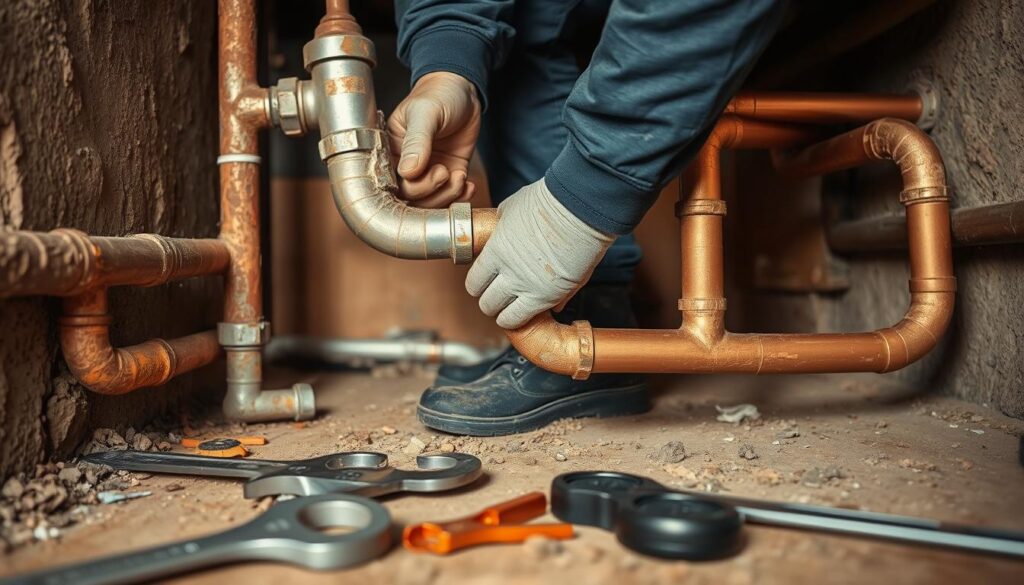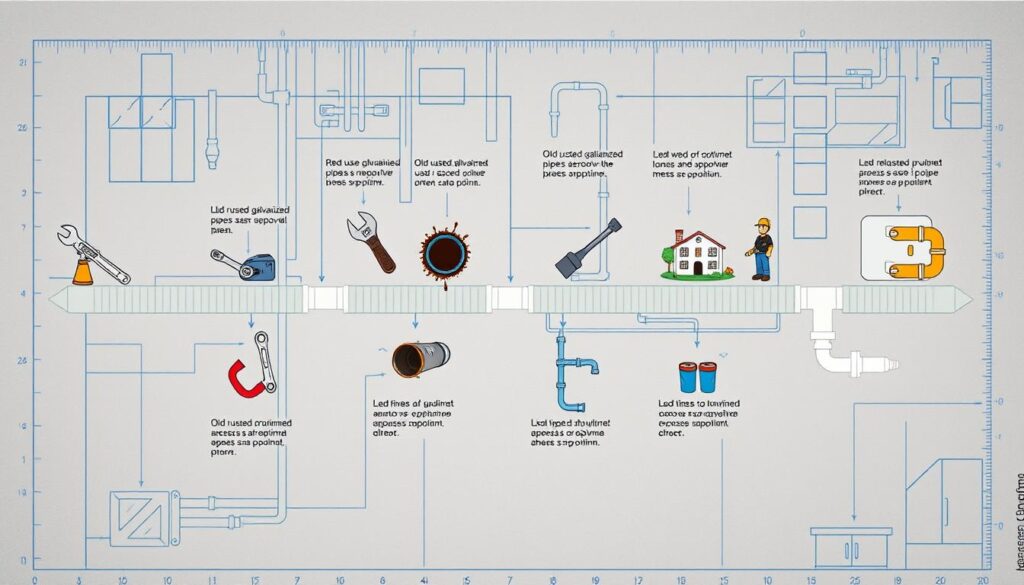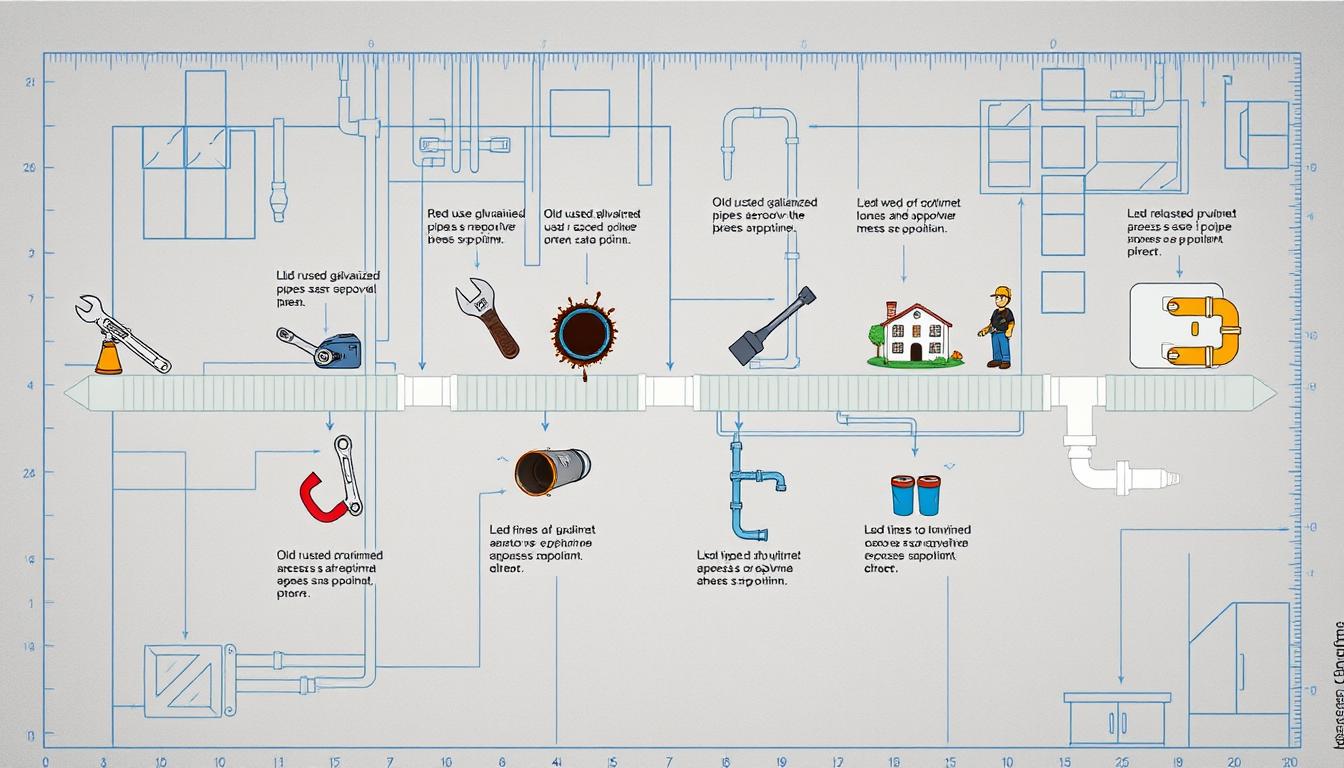Homeowners often face the challenge of keeping their plumbing systems in good shape. Replacing old galvanized pipes is a common issue, especially in older homes. This guide will help you understand the costs involved, making your home renovation planning easier.

Key Takeaways
- Galvanized pipes usually last 40-50 years, so replacing them is common in older homes.
- The cost to replace these pipes can be between $3,000 and $15,000 or more. This depends on your home’s size and the materials you choose.
- Several factors influence the cost. These include your home’s size, how easy it is to access the pipes, the type of material you pick (like copper or PEX), and the local labor rates.
- Replacing galvanized pipes can also improve your health by removing lead and rust risks.
- Choosing the right time for the project and picking a reliable contractor can help you save money.
Understanding Galvanized Pipes and Their Lifespan
Galvanized pipes have been used in homes for many years. They are made of steel coated with zinc, called galvanization. This zinc helps protect the steel from pipe corrosion and rust, keeping water quality better.
What Are Galvanized Pipes?
Galvanized pipes were popular in the 20th century, especially in older homes. The zinc coating guards against the elements. But, over time, the coating can wear off, causing galvanized plumbing problems.
Signs of Aging Galvanized Pipes
- Discolored or rusty water
- Reduced water pressure
- Frequent leaks or pipe bursts
- Buildup of mineral deposits inside the pipes
Average Lifespan of Galvanized Plumbing
Galvanized pipes usually last 20 to 50 years. This depends on water quality, location, and plumbing condition. In areas with hard or acidic water, the zinc coating wears off faster, shortening pipe life.
Keep an eye on your galvanized pipes and fix problems quickly. This can help them last longer and keep your plumbing system working well.
How Much Is It to Replace Galvanized Pipes: Complete Cost Breakdown
Replacing galvanized pipes can be a big expense for homeowners. Knowing the full cost helps you budget better. The cost depends on your home’s size, how easy it is to get to the pipes, and the new plumbing materials.
Let’s look at the usual pipe replacement cost for different home sizes:
- Small home (1,000-1,500 sq ft): $2,500 to $8,000
- Medium home (1,500-2,500 sq ft): $5,000 to $15,000
- Large home (2,500+ sq ft): $10,000 to $30,000
These prices include materials like copper or PEX and the labor needed. Remember, plumbing expenses can change a lot. This depends on the project’s complexity and where you live.
| Item | Cost Range |
|---|---|
| Materials (pipes, fittings, valves) | $1,000 – $5,000 |
| Labor (plumber hourly rate) | $50 – $150 per hour |
| Permits and Inspections | $100 – $500 |
| Cleanup and Disposal | $200 – $500 |
Knowing the usual home improvement budget for replacing galvanized pipes helps you prepare. It lets you make smart choices about your plumbing project.
Factors Affecting Galvanized Pipe Replacement Costs
Replacing old galvanized pipes can cost a lot. Several factors can change the price. Knowing these can help homeowners budget better and make smart choices.
Home Size and Plumbing Accessibility
The size of your home affects the cost. Bigger homes need more pipes, which costs more. Also, if pipes are hard to reach, it can add to the plumbing accessibility cost.
Material Choices for Replacement
Choosing the right pipe materials is important. Options like copper, PEX, or CPVC have different prices. The choice depends on durability, ease of install, and personal taste, affecting the cost.
Regional Labor Costs
Plumber labor costs vary by region. In expensive areas, labor costs are higher. This can greatly affect your total cost for replacing pipes.
Understanding these factors helps homeowners plan better. It ensures a smooth and affordable home improvement project.
Per-Square-Foot Cost Analysis for Pipe Replacement
Replacing galvanized pipes can cost a lot, depending on your home’s size and layout. Knowing these costs helps homeowners budget and plan for the project.
In a 1,500-square-foot home, the cost to replace pipes is $8 to $15 per square foot. This means the total cost could be between $12,000 and $22,500. For a 2,500-square-foot home, the cost per square foot is slightly lower, from $7 to $12 per square foot. This results in a total cost of $17,500 to $30,000.
Several factors affect these costs. These include how easy it is to access the pipes, the plumbing system’s complexity, and where your home is located. Homes with hard-to-reach pipes or complex layouts might cost more. Simpler homes might cost less.
| Home Size | Cost per Square Foot | Total Replacement Cost |
|---|---|---|
| 1,500 sq ft | $8 – $15 | $12,000 – $22,500 |
| 2,500 sq ft | $7 – $12 | $17,500 – $30,000 |
Understanding these per-square-foot plumbing estimates helps homeowners plan and budget for replacing galvanized pipes. Getting quotes from local plumbers can also help find the best deal for your home.

Material Options and Their Price Points
Homeowners have many choices when replacing galvanized pipes. Each option has its own benefits, costs, and fits different budgets and homes. Let’s look at the prices of copper pipes, PEX tubing, and CPVC plumbing.
Copper Piping Costs
Copper pipes are a classic choice for plumbing. They last long and resist corrosion. Copper costs between $3 to $12 per foot, based on size and quality.
While copper is pricier at first, its durability saves money over time.
PEX Piping Expenses
PEX tubing is popular for its flexibility and cost. It costs $0.50 to $3 per foot. This makes PEX a budget-friendly option.
PEX also handles temperature changes well, fitting many climates.
CPVC Installation Rates
CPVC plumbing is a good alternative to galvanized pipes. It’s durable, resists corrosion, and handles hot water. CPVC costs $1 to $5 per foot, a middle ground between copper and PEX.
Choosing the right material depends on your home, water quality, and budget. A professional plumber can guide you to the best choice for your needs.
Timeline and Labor Requirements for Replacement
Replacing galvanized pipes is a big plumbing job that needs careful planning. The plumbing project duration and installation time depend on your home’s size and the pipes’ location.
A full replacement can take 2 to 5 days. The labor hours needed are 20 to 40, based on the project’s size. For smaller jobs, like a single bathroom or kitchen, it might take 1 to 2 days with 8 to 16 hours of work.
- Several things can affect the plumbing project duration and labor hours. These include:
- The size and layout of your home
- The pipes’ accessibility, influenced by your home’s design
- The type of replacement pipes (e.g., copper, PEX, or CPVC)
- The plumbing system’s complexity and the number of fixtures to replace
- Generally, bigger homes with complex plumbing take longer to install. They also need more labor hours than smaller homes.
Choosing a reliable, experienced plumber is key. They can give you a detailed timeline and labor estimate for your project. This helps you plan and budget, making the process smoother and more efficient.

“Replacing galvanized pipes is a significant investment, but it’s an essential step in maintaining the long-term health and safety of your home’s plumbing system.”
Cost-Saving Strategies for Pipe Replacement
Replacing galvanized pipes can be expensive. But, there are ways to save money. By choosing the right time and contractor, homeowners can cut costs by hundreds or thousands of dollars.
Seasonal Timing Benefits
Plumbing costs change with the seasons. Prices are often lower in the fall and winter. This is because fewer people need plumbing services then.
Contractors offer plumbing discounts or off-season rates to get more customers. So, scheduling your project during these times can save you a lot of money.
Contractor Selection Tips
Finding the right contractor is key to saving money. Look at their experience, licenses, and references when comparing contractor comparisons. A good contractor might cost a bit more. But, they offer better service and quality, saving you money in the long run.
By using seasonal timing and picking a reliable contractor, homeowners can replace galvanized pipes more affordably and confidently.
Insurance Coverage and Financing Options
As a homeowner, dealing with plumbing insurance and financing can be tough. But knowing what’s out there can help you make good choices. This ensures a smooth process for your pipe replacement.
Plumbing Insurance Coverage
Many homeowner’s insurance policies cover plumbing issues, including replacing galvanized pipes. It’s key to check your policy and talk to your insurance company. They can tell you how much you’re covered for.
Some policies might cover the whole cost of new pipes. Others might have deductibles or limits.
Financing Options
If your insurance doesn’t cover enough or you need more money, there are home renovation loan options. You can look into:
- Home equity loans or lines of credit
- Home improvement loans for plumbing and renovation
- Personal loans with good terms for homeowners
Some plumbing contractors also offer payment plans. These plans let you pay over time, making it easier for homeowners.
| Financing Option | Typical Interest Rates | Loan Terms |
|---|---|---|
| Home Equity Loan | 4-8% | 5-30 years |
| Home Improvement Loan | 6-12% | 5-15 years |
| Personal Loan | 6-24% | 1-7 years |
It’s important to compare these options. Think about your finances and choose what works best for you.
“Investing in the replacement of your galvanized pipes is not only a wise financial decision but also a critical step in preserving the long-term value and safety of your home.”
Health Benefits of Replacing Galvanized Pipes
Switching from old galvanized pipes can greatly improve your home’s health. These pipes, once common, can harm water quality over time. Replacing them leads to better water quality improvement, less lead contamination, and stops rust problems.
Enhanced Water Quality
As galvanized pipes get older, they corrode and pollute your water. This can make your water look, taste, and smell bad. It can even contain lead, a dangerous toxin. Using new materials like copper or PEX can make your water clean and safe to drink.
Reduced Lead Exposure
Old galvanized pipes are a big health risk because of lead contamination. The zinc coating wears off, letting lead into your water. Switching to new pipes removes this risk, keeping your family safe from lead.
Rust Prevention
Galvanized pipes also rust, which worsens water quality and plumbing problems. Moving to materials that don’t rust keeps your water flowing well and clean.
| Health Benefit | Explanation |
|---|---|
| Water Quality Improvement | Replacing galvanized pipes can eliminate the release of harmful particles and contaminants into your water supply, leading to better taste and purity. |
| Lead Contamination Reduction | Galvanized pipes can break down over time, allowing lead solder to leach into the water. Upgrading to modern materials can significantly reduce this health risk. |
| Rust Prevention | Corrosion-resistant replacement pipes can prevent the buildup of rust, maintaining clean, uninterrupted water flow and improving overall plumbing performance. |
Fixing the health issues with old galvanized pipes makes your plumbing safer and more reliable. It’s a big upfront cost, but it’s worth it for your family’s health and your home’s water quality.
Signs You Need Immediate Pipe Replacement
There are clear signs that your home’s pipes need to be replaced. These signs are important because ignoring them can cause big problems. They can lead to plumbing emergencies, bad water quality, and damage to your home.
Water Quality Issues
One big sign is water discoloration. If your water looks rusty, brown, or tastes metallic, it’s time to act. This color change means the pipes are breaking down. It can also mean your water has harmful stuff in it.
Visible Pipe Damage
Another sign is pipe leaks or damage. Look for water stains, mold, or low water pressure. These are signs of pipe leaks or problems with your pipes. If you ignore these signs, you could face big water damage and expensive fixes.
It’s crucial to fix these problems fast. This keeps your home’s plumbing safe and working right. Don’t wait for a big plumbing emergency. Replace your pipes before they cause more harm.
Conclusion
Replacing galvanized pipes is a big step for your home’s plumbing. It’s an investment that can really pay off in the long run. Knowing how long these pipes last, what affects their cost, and the different materials you can choose from helps you make a smart choice.
This choice not only makes your plumbing better but also increases your home’s value. Fixing water quality issues and stopping water damage are just a few benefits. This project can make your home safer, more comfortable, and more valuable when you sell it.
If you own a home or invest in real estate, knowing about galvanized pipe replacement is key. By looking at your options and choosing trusted contractors, your galvanized pipe replacement will be a smart plumbing investment. It will also boost your home value and make your home more enjoyable to live in.
FAQ
What are galvanized pipes?
Galvanized pipes are a common plumbing material in older homes. They are made of steel with a zinc coating to stop corrosion.
How long do galvanized pipes typically last?
Galvanized pipes usually last 40-50 years. But, this can change based on water quality and how easy it is to access the pipes.
What are the signs that galvanized pipes need to be replaced?
Signs include discolored or bad-tasting water, low water pressure, and visible damage or corrosion.
How much does it typically cost to replace galvanized pipes?
Replacing galvanized pipes can cost between $3,000 and $15,000 or more. This depends on your home’s size, material choices, and local labor costs.
What are the benefits of replacing galvanized pipes?
Replacing them can improve water quality and lower the risk of lead contamination. It also prevents rust and leaks, boosting your home’s health and value.
When is the best time to replace galvanized pipes?
The best time is during the off-season. Plumbers might offer discounts and have more time. Replacing them early can also save you from expensive emergency repairs.
What are some cost-saving strategies for galvanized pipe replacement?
To save money, choose less expensive materials, hire local contractors, and plan the project during the off-season for discounts.
How can homeowners finance galvanized pipe replacement?
Homeowners can look into home improvement loans, payment plans with contractors, or check if insurance covers the project.



